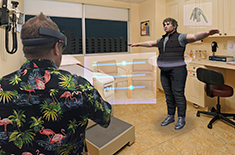EAE Play! on Dec. 9
December 5, 2016

Virtual reality is all the rage in video gaming, and the University of Utah’s No. 1-ranked Entertainment Arts & Engineering (EAE) video game development program is exploring all the ways this hyper-realistic form of interactivity can be informative as well as fun.
Five new VR games and educational apps along with more than 30 other games will be on display during the new EAE Play! event, a showcase of the program’s student games under production this year, from high-octane shooting games to medical apps that help sufferers with conditions such as diabetes and autism. And for the first time, EAE is inviting the public to playtest the games and give feedback to the student designers.
EAE Play! will be held Friday, Dec. 9, from 1 to 5 p.m. in the top floor of the studio’s new home in the former law library, 332 S. 1400 East (free parking is available on the east side of the building). It is free and open to the public.
Some of the virtual reality games on display include:
Autism Choreographic Experience – This VR app helps young adults with autism understand spacial reasoning by allowing the user to conduct a school of fish in an underwater dance.
Augmented Reality Body Image – An app to help diagnose those who suffer from body-image disorder in which they use the Microsoft HoloLens augmented reality helmet to describe the size and shape of their body. This can help raise awareness of their true body shape.
Virtual Records – A VR app for sufferers of Type 2 Diabetes to help them visualize their data, for example, a graph of their blood glucose readings that is transformed into the peaks of a mountain.
After School – A first-person VR educational game for the Google Cardboard that strengthens vocabulary by helping kids learn to associate words with images.
Wrecked: Get Your Ship Together – A living room party game for VR that integrates the VR player with other players on their mobile phones.
Other games that will be available to demo include a first-person puzzle game, a combat cart racer, a virtual form of hide-and-seek, and an art-driven 3D simulator that “invokes discussion about the colorfulness and beauty of the world.”
EAE co-founder and executive director Robert Kessler, a professor in the University of Utah’s School of Computing, said organizers are allowing the public to playtest the student games for the first time to give student designers critical feedback on issues like gameplay, graphics and user interface.
“EAE students learn that game development is unique to other forms of software development because you don’t know if the game will be fun until someone actually plays it,” he says. “We are excited to invite the public behind the scenes of student game development to come out, test, and help improve dozens of games that our over 200 undergraduate and graduate students have been creating this year.”
The games represent the work of the program’s seniors, master’s students, and GApp Lab, which creates interactive software for education and medical applications. Most of the games are scheduled to be published next spring.
EAE is the No. 1 undergraduate school in the nation for studying game design, according to the latest survey by Princeton Review, and the EAE graduate program is ranked No. 3. EAE recently moved into its new home in the U’s former law library combining what was once three smaller studios on campus into one large, integrated studio on the top floor.